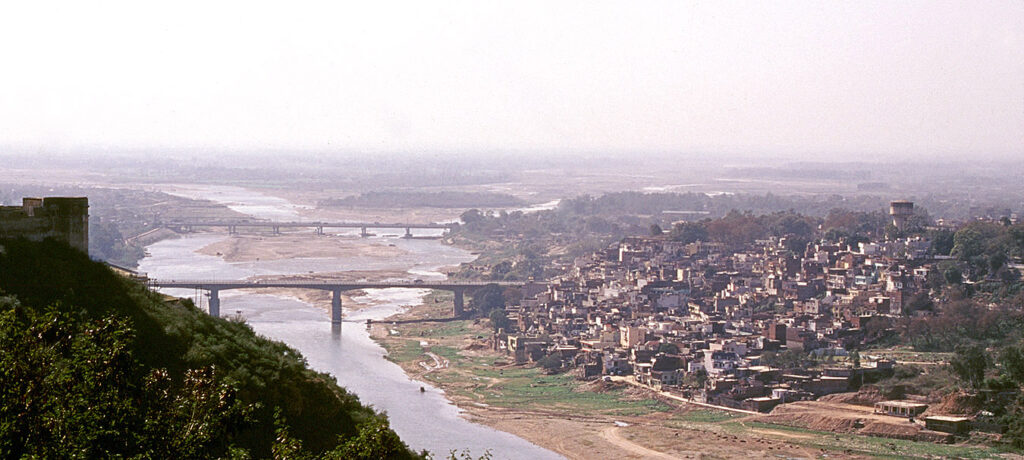Environmentalists Concerned As Work On Tawi Riverfront Continues
Jul 8, 2023 | Pratirodh Bureau
The riverfront development project aims to develop the river Tawi in Jammu and Kashmir and create business opportunities (Photo by Paul La Porte/Wikimedia Commons)
Environmental activists have raised concerns about the government’s Tawi riverfront development project in Jammu and Kashmir stating that it poses a threat to the environment, as the impacts of climate change worsen.
The 530-crore project aims to rejuvenate groundwater sources by creating an artificial lake and wayside amenities to boost tourism. Last year, Jammu and Kashmir’s Lieutenant Governor Manoj Sinha had laid the foundation stone for the project, after it encountered several delays over the past 13 years. At an inspectional visit in March 2023, he told the media that the vibrant riverfront will ensure urban infrastructure sustainability, unique business opportunities and will enhance the quality of life of the citizens.
The project is being developed on the lines of the Sabarmati riverfront in Gujarat. Incidentally, the Sabarmati river submerged at least four times in recent years: 2006, 2011, 2015 and 2017.
The Tawi river, which flows through the city of Jammu, is one of the major left-bank tributaries of the river Chenab. It is a major source of drinking water for the old city and is also considered sacred in Hinduism. However, the untreated sewage discharged, pollutes the river, that passes through the city. In recent years, the flow of water in the river too, has been decreasing.
The (riverfront development) project will increase the aesthetic value of Tawi by enhancing natural purifying capabilities, as well as promoting environmental and urban infrastructure sustainability, said Avny Lavasa, the former Chief Executive Officer of Jammu Smart City Ltd (JSCL), which is one of the partners for the river development, in a media report in January. Lavasa is now Deputy Commissioner Jammu.
Activists Resist The Development Plan
A youth group called Friends of River Tawi (FORT), is resisting the government plan for riverfront development on Tawi and is raising awareness among the public about the possible negative impacts of the project. Anmol Ohori, a member of FORT, told Mongabay India that the project, on paper, aims to beautify the city and boost tourism and that “it is more focused on commercialisation and concretisation”. “This will be destructive [to the environment] as the climate crisis worsens, and Jammu and Kashmir being one of the Himalayan states will bear the brunt of it.”
Ohori added that their team of climate experts has raised concerns regarding the project, claiming that it is being developed by reclaiming a large patch of land from the riverbed, starting from the riverbank inside the river, approximately 200 feet each from both sides. “This will decrease the width of the river at the heart of the city, which will in turn, increase the pressure of the water flow in river Tawi, further increasing the possibility of flooding,” he said.
On June 5, the youth group staged a protest against the project. In a memorandum that they handed over to the government officials, they stated that currently the river’s course has been temporarily changed for ease of construction and no preservation of natural habitat in and around the river has been taken into consideration before doing so. “What measures are being taken to protect the river’s ecosystem during and after the development project?” the memorandum asks.
Jammu-based environmentalist Rupak Chand told Mongabay India that public money is being wasted on this project. “If they [the government] want to beautify the Tawi, let them start the restoration process in the upper part. They are promoting business there, rather than nature.”
Recent Floods
The Tawi river caused flooding in the adjoining areas in 2013, where the pressure of the water increased to an extent that a major part of the bridge that ran over the river collapsed. The city’s lower-lying areas had to bear a heavy loss of property. In 2020, during heavy rainfall, a portion of another bridge in Jammu collapsed, leading to the death of one person.
Bhushan Parimoo, another Jammu-based environmentalist, said, “Controlling the flow of the river will impact the already extinct aquatic life in the river. Before 1947, the river was home to more than 60 species of aquatic life, and this has already come down to four or five species due to constant neglect of the ecological status of the river.”
Ohori further added that owing to the hilly terrain of the Himalayan landscape, there is the possibility of cloudbursts too. According to him, as part of this Tawi front project, the authorities have shortened the streams of Tawi, which will directly affect the population of Jammu at the time of floods. “No loss of lives has been reported so far. But we believe if this project is made, there will be a loss of lives, particularly in urban Jammu areas,” he said.
“The project claims to mitigate floods by channelising the river,” he said. “For this, the river width is being decreased by approximately 420 feet. Doesn’t this pose a serious risk of flooding during heavy rain?” Ohori questioned.
Local residents also worry that the project is likely to impact the adjoining notified wetlands such as the Gharana Wetland, as the flow of water is artificially regulated, and this could impact the natural habitat of the migratory birds. Last year, the Jammu and Kashmir High Court modified an order dated November 17, 2016, which had imposed a blanket ban on mining in river Tawi for private persons. The revised order directed that the relevant authorities of the government were at liberty to get minor minerals extracted from Tawi, subject to strict adherence to the Rules of 2016 and the recommendations of the committees. The raw material used in this project are being taken from the riverbed of Tawi.
(Published under Creative Commons from Mongabay-India. Read the original article here)
